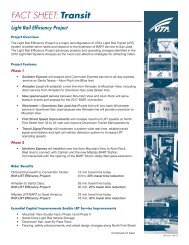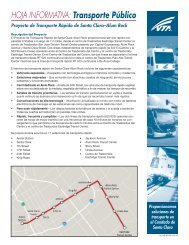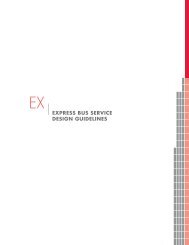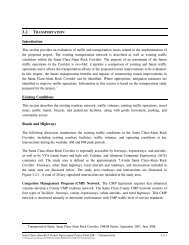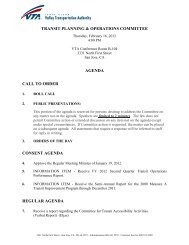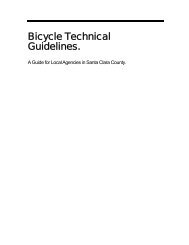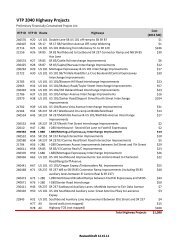Appendix I - Hazardous Materials Documentation - VTA
Appendix I - Hazardous Materials Documentation - VTA
Appendix I - Hazardous Materials Documentation - VTA
You also want an ePaper? Increase the reach of your titles
YUMPU automatically turns print PDFs into web optimized ePapers that Google loves.
Contaminant Management Plan, SVRT/BART Extension<br />
hydrocarbons within the motor oil range (TPH-MO). Additionally, a large stockpile of soil was identified as<br />
containing relatively high levels of chromium.<br />
The lead and petroleum hydrocarbon results from these investigations can be summarized as follows:<br />
• The shallow soil beneath the ballast (0 to 3 feet bgs) contains sufficient total and extractable lead to<br />
require the material be handled as a California Regulated Waste if disposal is considered.<br />
• One shallow soil sample contained a lead level high enough for the soil to be classified as a Resource<br />
Conservation and Recovery Act (RCRA) hazardous waste.<br />
• Data on deeper soil samples (3 to greater than 20 feet bgs) indicates that lead concentrations are not<br />
sufficient to require classification of the soil as a RCRA hazardous waste or California (non-RCRA)<br />
hazardous waste.<br />
• TPH-MO was found in approximately half of the shallow (up to a depth of 2 feet) soil samples at<br />
concentrations exceeding 100 mg/kg, up to a level of 25,000 mg/kg.<br />
• Significant concentrations of TPH-MO were not detected in soil samples collected from depths of 5<br />
feet or greater.<br />
2.4.2 Impacts to Groundwater<br />
2.4.2.1 Line Segment<br />
Investigations of groundwater quality have been focused where retained cuts, depressed crossroads, and deep<br />
foundation footings are proposed and dewatering may be required. Depth to groundwater along the SVRT<br />
alignment is approximately 15 to 20 feet bgs, which may locally occur under confined or semi-confined<br />
conditions.<br />
Based on the investigations described in Section 2.3.1, groundwater removed during dewatering activities is<br />
not expected to be contaminated with dissolved metals, although total metals levels (including metals in<br />
suspended solids) may be significant in some locations. In some locations, the groundwater is expected to be<br />
contaminated with organic chemicals from off-site sources. These locations include:<br />
• Just north of Montague Expressway, where groundwater is impacted by a chlorinated solvent plume<br />
commonly referred to as the Jones Chemical plume, and groundwater treatment system piping passes<br />
under the UPRR tracks. This plume includes chlorinated solvents at concentrations generally below<br />
200 micrograms per liter (µg/L);<br />
• Just north of Montague Expressway, where groundwater on the adjacent Great Mall (formerly the<br />
Ford Automobile Assembly Plant) property is impacted with residual petroleum hydrocarbons. Note<br />
that the Jones Chemical Plume also extends onto this property; and<br />
• The Kato Road underpass area, where groundwater is impacted by the Scott Creek Business Park<br />
chlorinated solvent and diesel plume, where levels are generally below 100 µg/L.<br />
101248 – July 2008 Page 22



